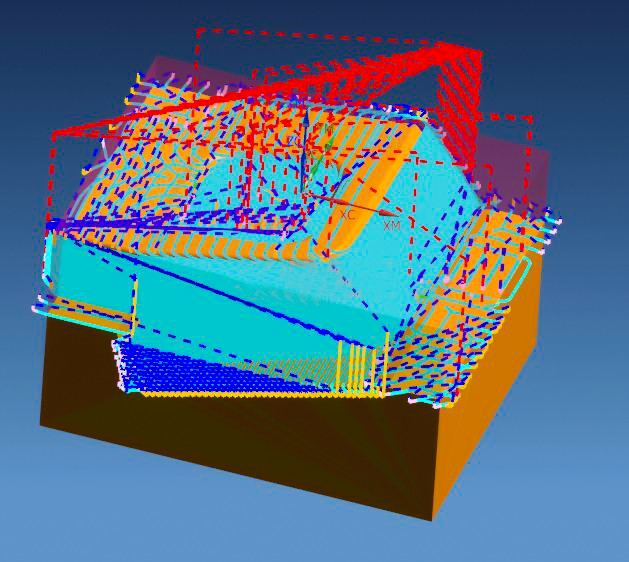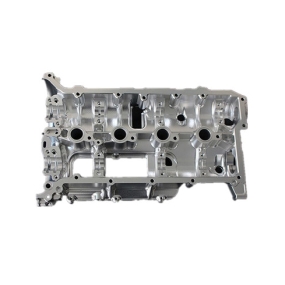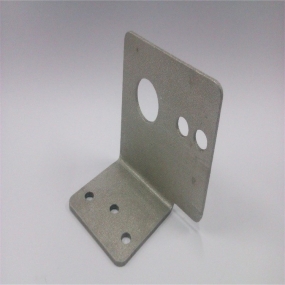General Principles of Knife Path
Rough cutting: Under the maximum load of the machine tool, in most cases, the largest possible tool, the largest possible feed rate, and the fastest possible feed should be selected. In the case of the same knife, the feed rate is inversely proportional to the feed amount. In general, the load of the machine tool is not a problem, and the principle of tool selection mainly depends on whether the two-dimensional angle and three-dimensional arc of the product are too small. After selecting the knife, the length of the knife should be determined. The principle is that the length of the knife should be greater than the machining depth, and for large workpieces, the interference of the chuck should be considered.
Light knife: The purpose of a light knife is to achieve the machining requirements of meeting the surface smoothness of the workpiece and reserving appropriate allowance. Similarly, for a light knife, choose the largest possible knife and the fastest possible time, as a precision knife requires a longer time, so use the most suitable feed and feed. Under the same feed rate, the larger the horizontal feed, the faster the feed rate. The amount of surface feed is related to the smoothness after machining, and the size of feed is related to the external shape of the surface. Without damaging the surface, leave the smallest margin, use the largest knife, the fastest speed, and appropriate feed rate.
 Clamping method
Clamping method
1. All clamps are horizontally long and vertically short.
2. Tiger pliers clamping: The clamping height should not be less than 10 millimeters, and the clamping height and processing height must be indicated when processing workpieces. The processing height should be about 5 millimeters higher than the plane of the vise, in order to ensure firmness and not damage the vise. This type of clamping is a general clamping, and the clamping height is also related to the size of the workpiece. The larger the workpiece, the higher the clamping height.
3. Clamping: The clamping plate is mounted on the workbench with a code, and the workpiece is locked onto the clamping plate with screws. This type of clamping is suitable for workpieces with insufficient clamping height and high processing force, generally medium and large workpieces, and has a better effect.
4. Code iron clamping: When the workpiece is large, the clamping height is not enough, and it is not allowed to lock the screw at the bottom, code iron clamping is used. This type of clamping requires secondary clamping. First, code the four corners, process the other parts, and then code the four sides and process the four corners. During secondary clamping, do not let the workpiece loosen, code first and then loosen. You can also code both sides first and process the other two sides.
5. Clamping of cutting tools: with a diameter of 10mm or more, the clamping length shall not be less than 30mm; Diameter below 10mm, clamping length not less than 20mm. The clamping of the cutting tool should be firm to prevent collision and direct insertion into the workpiece.
Classification and scope of application of cutting tools
1. Classified by material:
White steel knife: easy to wear, used for rough cutting of copper and small steel materials.
Tungsten steel knife: used for corner cleaning (especially for steel materials) and smooth cutting.
Alloy knife: Similar to tungsten steel knife.
● Purple knife; Used for high-speed cutting, not easily worn.
2. Divided by blade:
Flat bottomed knife: used for flat and straight side surfaces, cleaning flat corners.
Ball knife: used for various curved surfaces with light and light knives.
Bull nose knife (with single-sided, double-sided, and five sided options): used for rough cutting of steel materials (R0.8, R0.3, R0.5, R0.4).
Coarse skin knife: used for rough cutting, pay attention to the margin (0.3).
3. Divided by blade:
● Straight pole knife: Straight pole knife is suitable for various occasions.
Slant bar knife: but not suitable for straight surfaces and surfaces with a slope smaller than the slope of the bar.
4. Divided by blade:
Two blade, three blade, four blade, the more blades there are, the better the effect, but the more work done, the corresponding adjustment of speed and feed, and the longer the lifespan of more blades.
5. The difference between a ball knife and a flying knife:
Ball knife: When the concave ruler is smaller than the ball ruler and the flat ruler is smaller than the ball R, the light cannot reach (cannot clear the bottom angle).
Flying Knife: Its advantage is that it can clear the corners. Mechanical enthusiasts can follow Intuitive Learning of Mechanical Micro Signals. Comparison of the same parameters: V=R * ω Speed is much faster (flying knife), the light output is brighter, flying knives are more commonly used for contour shapes, and sometimes flying knives do not require mid light. The disadvantage is that the concave surface size and the flat ruler are smaller than the diameter of the flying knife and cannot be reached.
 Drawing quantity issue
Drawing quantity issue
1. In the absence of a ready-made machining surface, the plane is divided into four sides, with the center facing the origin and the top facing zero. When the top surface is not flat (for copper), a margin of 0.1 is left, that is, when the collision number is reached, the actual value of 0 (z) is lower by 0.1 on the graph.
2. When there is a ready-made machining surface, make the ready-made surface on the drawing 0 (z), and if the plane can be divided into centers, then divide it into centers. Otherwise, if the machining surface is based on the ready-made edge collision number (single-sided), the actual height, width, and length differences from the drawing need to be checked and programmed according to the actual material. Generally, the dimensions on the drawing are processed first, and then the shapes on the drawing are processed.
3. When multiple positions need to be processed, the first position (standard position) needs to be aligned with the reference points of the other positions, including length, width, and height. All the next processing reference points should be based on the previously processed surface.
4. Positioning of the inlay: Place it inside the whole, raise the bottom to a certain height, and then raise the drawing to this height. The plane should be centered according to the whole, and the height should be locked with screws below the drawing; If it is square, it can be directly divided into two parts; Roughly speaking, the maximum possible shape score can be used; Cut a fixture, divide it according to the fixture, determine the relative position between the insert diagram and the fixture, and then place the origin of the drawing at the center point of the fixture.
Rough knife path selection
1. Surface excavation groove
The key is the selection of scope and surface.
The machining area of the cutting path is based on the selected surface within the selected range as the termination surface, and the principle is to use all the places that the tool can go down from the highest point to the lowest point. The selected surface should preferably be a full surface, and the boundary can only be the area to be processed. The area without surface should extend less than half of the tool diameter, as there is enough margin left for other surfaces to be automatically protected; It is best to extend the lowest line, as there is an R gong that cannot reach the lowest point.
● Knife selection: If the tool cannot be threaded or diagonally fed, or if the area cannot be machined, the area where the tool cannot be fed will be sealed and left for secondary roughing.
Before cutting with a light knife, it is necessary to roughen all the areas that have not been roughened, especially the small corners, including two-dimensional corners, three-dimensional corners, and sealed areas, otherwise the knife will break. Mechanical enthusiasts can follow Intuitive Learning of Mechanical Micro Signals. Secondary roughing: Generally, a three-dimensional groove selection range is used, with a flat bottomed knife. If it is possible to use a flat groove and an external cutting path, it is used. Without damaging other surfaces, the center of the tool should be aligned with the selected boundary. Generally, the boundary should not be finely trimmed, and quick bi-directional angles should be used depending on the situation. Spiral cutting should be done at an angle of 1.5 degrees and a height of 1. When the groove shape is strip-shaped and cannot be lowered by spiral cutting, diagonal cutting should be used. Generally, the filter should be opened, especially for rough curved surfaces. The cutting plane should not be low to avoid collision, and the safety height should not be low.
● Knife retraction: Generally, relative retraction is not necessary, absolute retraction is used, and relative retraction is used when there are no islands.
2. Flat excavation groove
Milling various flat surfaces, concave and flat grooves. When milling partially open flat surfaces, boundaries need to be determined, and the principle is to be able to feed (greater than one tool diameter). The open area should be more than half the tool diameter, and the periphery should be closed.
3. Appearance
When the selected plane is suitable for contour layering, use contour layering to lift the knife (planar contour). When the lifting point and the lower cutting point are the same point, there is no need to lift the knife. Generally, lift the knife on the z-plane and try not to use relative height; The correction direction is generally right correction (straight knife).
4. Mechanical correction of knife path setting
The correction number is 21, and the computer correction and mechanical correction will be changed. The feed will be vertical, and if the knife cannot pass through, the R will be increased without leaving any margin.
5. Equal height appearance
Suitable for closed surfaces. For open surfaces, if there are four circles, the top surface should be sealed. If there are four circles or not, the range and height should be selected (with a certain arc feed for rough cutting). This is used for rough cutting situations: if the machining distance in any plane is less than one tool diameter, a larger tool or two equally high shapes should be used if it is greater than one tool diameter.
6. Curved streamline
Having the best uniformity and dry brittleness, it is suitable for light knives and can often replace high profile shapes.
7. Radiation knife path
Suitable for situations with large holes in the middle (use less). Attention: When using a flexible knife, if the knife is not sharp, too long, or the workpiece is too deep, it should be wrapped around and not moved up or down; The two sides of the sharp angle in the workpiece should be divided into two cutting paths, which cannot be crossed over. It is best to extend the edge of the smooth cutting (using an arc to advance and retreat the cutting).
Qingjiao
1. The corner cleaning here refers to the two-dimensional blind spots, which have not been reached in the previous processes. If the light knife needs to reach a certain area, the corner should be cleaned first before the light knife. For corners that are too small, too large, and too deep, several knives can be used to clean them. Do not use a small knife to clean too many areas.
2. Clear 3D corners: Make some small slots, some 3D corners.
3. For easily breakable knives, it is necessary to consider situations such as thin knives, excessive length, and large processing volume (mainly in the z-direction and depth direction).
4. Knife path: Using a two-dimensional shape, only small angles (R0.8) and two-dimensional plane angles can be cleared; Using parallel knife paths; Using a contour of equal height; There is a type of curved surface that cannot be reached by a knife or a dead corner that cannot be reached by the shape. The knife should be sealed first, and then the corner should be cleaned. Small gaps in the larger surface are usually sealed first.
Zhongguang
1. Zhongguang: Steel materials and fine grains that are curved surfaces have a Zhongguang effect.
2. Principle: When cutting with a large knife, there should be more margin between layers. In order to achieve better results when cutting with a light knife,
3. Features: Quick clearance, large knives can also be used, large feed rate, large spacing; Don‘t worry about surface quality; Flat workpieces do not need to be exposed to light; For workpieces with high profile, medium gloss is not necessary. When opening with high profile, the two processes can be combined with a finer one, which refers to the surface allowance and the distance between layers; Whether medium light is needed or not, another important factor is the working material. The harder the material, the medium light should be considered; The processing direction of Zhongguang is preferably relative to the rough cutting of the light knife, which will result in better and more uniform processing effects.
Light knife
The light knife needs to meet the assembly requirements of various products and molds, so it is necessary to be very cautious and provide different knife path settings and parameter settings according to different requirements.
1. The cutting height and final height of the light knife are both changed to 0, with a tolerance design within 1 thread, and no filtering is required (the smaller the workpiece, the smaller the tolerance, which affects the appearance).
2. The front mold and parting surface should achieve the best smoothness, the rear mold can be secondary, and other non matching and void avoiding surfaces can have rough spots.
3. The design of the knife path is determined by the following factors:
Specific appearance (such as flat and other surfaces), steep and flat surfaces.
Is there a sharp angle between the two sides (if sharp, separate them).
Are there different requirements for the two parts (whether to leave a margin, how much margin, and different requirements for smoothness).
The issue of protecting the surface in the light knife is a major problem, and the already processed surface must be protected against errors during processing and protected according to the requirements of the protective surface. Range protection, zero protection regardless of error, height range and plane range; Protective surface protection.
The issue of extending the cutting path is that in a smooth knife, it is best to make a circular advance and retreat when the cutting path reaches the edge, otherwise the surface will be slightly extended in advance.
The issue of lifting the knife in the light knife. Lifting a knife wastes time, so try to avoid lifting it as much as possible.
Method 1: Set the gap between the lifting blades (small gap)
Method 2: Cover and seal the knife lifting area (small gap)
Method 3: Avoid gaps (large gaps)
Method 4: Extend to the same height when the contour is of equal height
The issue of feed in the light knife requires that the first feed must be made from the outside of the workpiece to avoid vibration and damage to the workpiece. All light knives must be equipped with feed in.
Wear and tear of cutting tools: When the workpiece is large, multiple cutting tools are needed to polish the same workpiece.



 Spanish
Spanish Arabic
Arabic Portuguese
Portuguese Belarusian
Belarusian Japanese
Japanese Russian
Russian Icelandic
Icelandic Bulgarian
Bulgarian Azerbaijani
Azerbaijani Estonian
Estonian Irish
Irish Polish
Polish Persian
Persian Boolean
Boolean Danish
Danish German
German French
French Filipino
Filipino Finnish
Finnish Korean
Korean Dutch
Dutch Galician
Galician Catalan
Catalan Czech
Czech Croatian
Croatian Latin
Latin Latvian
Latvian Romanian
Romanian Maltese
Maltese Malay
Malay Macedonian
Macedonian Norwegian
Norwegian Swedish
Swedish Serbian
Serbian Slovak
Slovak Slovenian
Slovenian Swahili
Swahili Thai
Thai Turkish
Turkish Welsh
Welsh Urdu
Urdu Ukrainian
Ukrainian Greek
Greek Hungarian
Hungarian Italian
Italian Yiddish
Yiddish Indonesian
Indonesian Vietnamese
Vietnamese Haitian Creole
Haitian Creole Spanish Basque
Spanish Basque











